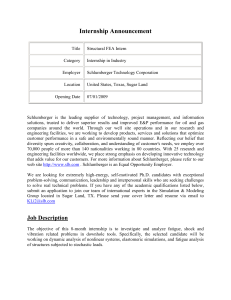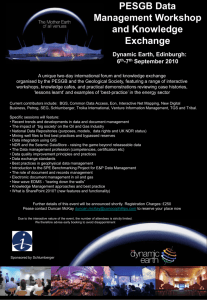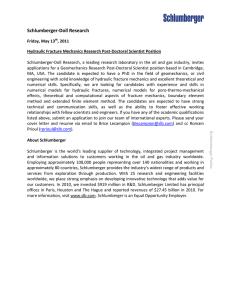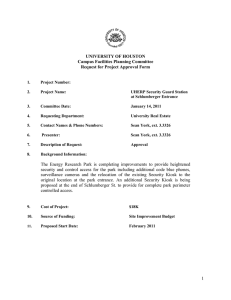Contributors - Schlumberger
advertisement
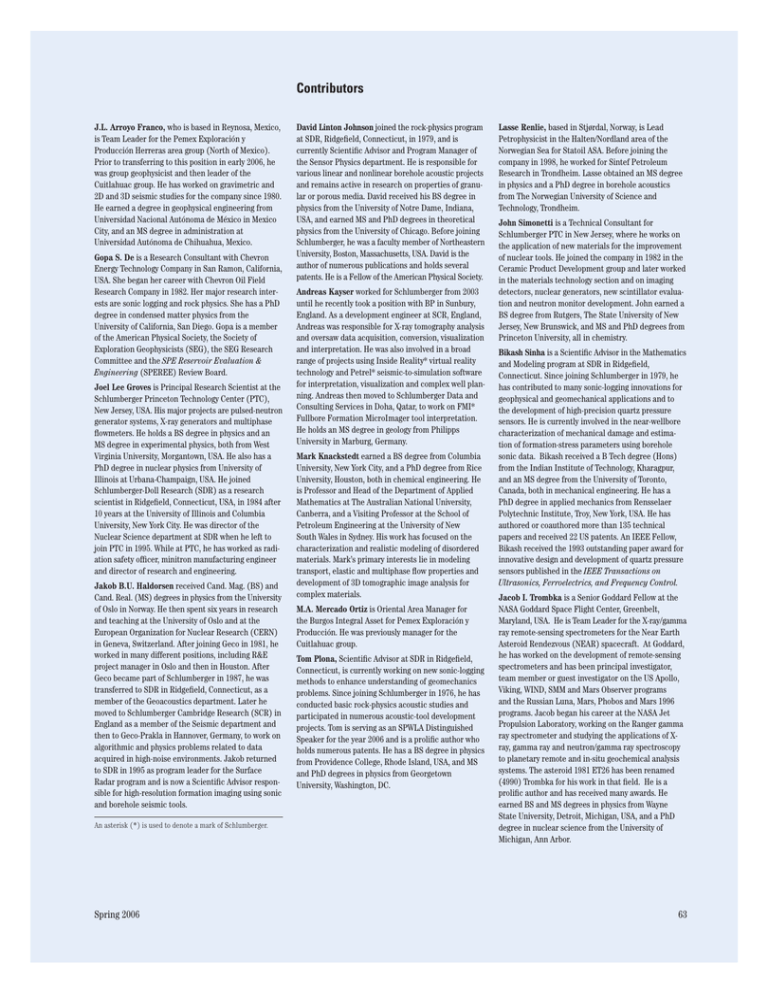
Contributors J.L. Arroyo Franco, who is based in Reynosa, Mexico, is Team Leader for the Pemex Exploración y Producción Herreras area group (North of Mexico). Prior to transferring to this position in early 2006, he was group geophysicist and then leader of the Cuitlahuac group. He has worked on gravimetric and 2D and 3D seismic studies for the company since 1980. He earned a degree in geophysical engineering from Universidad Nacional Autónoma de México in Mexico City, and an MS degree in administration at Universidad Autónoma de Chihuahua, Mexico. Gopa S. De is a Research Consultant with Chevron Energy Technology Company in San Ramon, California, USA. She began her career with Chevron Oil Field Research Company in 1982. Her major research interests are sonic logging and rock physics. She has a PhD degree in condensed matter physics from the University of California, San Diego. Gopa is a member of the American Physical Society, the Society of Exploration Geophysicists (SEG), the SEG Research Committee and the SPE Reservoir Evaluation & Engineering (SPEREE) Review Board. Joel Lee Groves is Principal Research Scientist at the Schlumberger Princeton Technology Center (PTC), New Jersey, USA. His major projects are pulsed-neutron generator systems, X-ray generators and multiphase flowmeters. He holds a BS degree in physics and an MS degree in experimental physics, both from West Virginia University, Morgantown, USA. He also has a PhD degree in nuclear physics from University of Illinois at Urbana-Champaign, USA. He joined Schlumberger-Doll Research (SDR) as a research scientist in Ridgefield, Connecticut, USA, in 1984 after 10 years at the University of Illinois and Columbia University, New York City. He was director of the Nuclear Science department at SDR when he left to join PTC in 1995. While at PTC, he has worked as radiation safety officer, minitron manufacturing engineer and director of research and engineering. Jakob B.U. Haldorsen received Cand. Mag. (BS) and Cand. Real. (MS) degrees in physics from the University of Oslo in Norway. He then spent six years in research and teaching at the University of Oslo and at the European Organization for Nuclear Research (CERN) in Geneva, Switzerland. After joining Geco in 1981, he worked in many different positions, including R&E project manager in Oslo and then in Houston. After Geco became part of Schlumberger in 1987, he was transferred to SDR in Ridgefield, Connecticut, as a member of the Geoacoustics department. Later he moved to Schlumberger Cambridge Research (SCR) in England as a member of the Seismic department and then to Geco-Prakla in Hannover, Germany, to work on algorithmic and physics problems related to data acquired in high-noise environments. Jakob returned to SDR in 1995 as program leader for the Surface Radar program and is now a Scientific Advisor responsible for high-resolution formation imaging using sonic and borehole seismic tools. An asterisk (*) is used to denote a mark of Schlumberger. Spring 2006 David Linton Johnson joined the rock-physics program at SDR, Ridgefield, Connecticut, in 1979, and is currently Scientific Advisor and Program Manager of the Sensor Physics department. He is responsible for various linear and nonlinear borehole acoustic projects and remains active in research on properties of granular or porous media. David received his BS degree in physics from the University of Notre Dame, Indiana, USA, and earned MS and PhD degrees in theoretical physics from the University of Chicago. Before joining Schlumberger, he was a faculty member of Northeastern University, Boston, Massachusetts, USA. David is the author of numerous publications and holds several patents. He is a Fellow of the American Physical Society. Andreas Kayser worked for Schlumberger from 2003 until he recently took a position with BP in Sunbury, England. As a development engineer at SCR, England, Andreas was responsible for X-ray tomography analysis and oversaw data acquisition, conversion, visualization and interpretation. He was also involved in a broad range of projects using Inside Reality* virtual reality technology and Petrel* seismic-to-simulation software for interpretation, visualization and complex well planning. Andreas then moved to Schlumberger Data and Consulting Services in Doha, Qatar, to work on FMI* Fullbore Formation MicroImager tool interpretation. He holds an MS degree in geology from Philipps University in Marburg, Germany. Mark Knackstedt earned a BS degree from Columbia University, New York City, and a PhD degree from Rice University, Houston, both in chemical engineering. He is Professor and Head of the Department of Applied Mathematics at The Australian National University, Canberra, and a Visiting Professor at the School of Petroleum Engineering at the University of New South Wales in Sydney. His work has focused on the characterization and realistic modeling of disordered materials. Mark’s primary interests lie in modeling transport, elastic and multiphase flow properties and development of 3D tomographic image analysis for complex materials. M.A. Mercado Ortiz is Oriental Area Manager for the Burgos Integral Asset for Pemex Exploración y Producción. He was previously manager for the Cuitlahuac group. Tom Plona, Scientific Advisor at SDR in Ridgefield, Connecticut, is currently working on new sonic-logging methods to enhance understanding of geomechanics problems. Since joining Schlumberger in 1976, he has conducted basic rock-physics acoustic studies and participated in numerous acoustic-tool development projects. Tom is serving as an SPWLA Distinguished Speaker for the year 2006 and is a prolific author who holds numerous patents. He has a BS degree in physics from Providence College, Rhode Island, USA, and MS and PhD degrees in physics from Georgetown University, Washington, DC. Lasse Renlie, based in Stjørdal, Norway, is Lead Petrophysicist in the Halten/Nordland area of the Norwegian Sea for Statoil ASA. Before joining the company in 1998, he worked for Sintef Petroleum Research in Trondheim. Lasse obtained an MS degree in physics and a PhD degree in borehole acoustics from The Norwegian University of Science and Technology, Trondheim. John Simonetti is a Technical Consultant for Schlumberger PTC in New Jersey, where he works on the application of new materials for the improvement of nuclear tools. He joined the company in 1982 in the Ceramic Product Development group and later worked in the materials technology section and on imaging detectors, nuclear generators, new scintillator evaluation and neutron monitor development. John earned a BS degree from Rutgers, The State University of New Jersey, New Brunswick, and MS and PhD degrees from Princeton University, all in chemistry. Bikash Sinha is a Scientific Advisor in the Mathematics and Modeling program at SDR in Ridgefield, Connecticut. Since joining Schlumberger in 1979, he has contributed to many sonic-logging innovations for geophysical and geomechanical applications and to the development of high-precision quartz pressure sensors. He is currently involved in the near-wellbore characterization of mechanical damage and estimation of formation-stress parameters using borehole sonic data. Bikash received a B Tech degree (Hons) from the Indian Institute of Technology, Kharagpur, and an MS degree from the University of Toronto, Canada, both in mechanical engineering. He has a PhD degree in applied mechanics from Rensselaer Polytechnic Institute, Troy, New York, USA. He has authored or coauthored more than 135 technical papers and received 22 US patents. An IEEE Fellow, Bikash received the 1993 outstanding paper award for innovative design and development of quartz pressure sensors published in the IEEE Transactions on Ultrasonics, Ferroelectrics, and Frequency Control. Jacob I. Trombka is a Senior Goddard Fellow at the NASA Goddard Space Flight Center, Greenbelt, Maryland, USA. He is Team Leader for the X-ray/gamma ray remote-sensing spectrometers for the Near Earth Asteroid Rendezvous (NEAR) spacecraft. At Goddard, he has worked on the development of remote-sensing spectrometers and has been principal investigator, team member or guest investigator on the US Apollo, Viking, WIND, SMM and Mars Observer programs and the Russian Luna, Mars, Phobos and Mars 1996 programs. Jacob began his career at the NASA Jet Propulsion Laboratory, working on the Ranger gamma ray spectrometer and studying the applications of Xray, gamma ray and neutron/gamma ray spectroscopy to planetary remote and in-situ geochemical analysis systems. The asteroid 1981 ET26 has been renamed (4990) Trombka for his work in that field. He is a prolific author and has received many awards. He earned BS and MS degrees in physics from Wayne State University, Detroit, Michigan, USA, and a PhD degree in nuclear science from the University of Michigan, Ann Arbor. 63 Stefan Vajda is Principal Research Scientist and now works in nuclear detectors at the Schlumberger PTC in New Jersey. He holds an MS degree from the University of Bucharest, Romania, and a PhD degree from the Institute for Nuclear Physics and Engineering, Bucharest/Magurele, Romania, both in physics. Stefan joined the company in 1984, working as a research physicist in neutron and X-ray generators. He later worked on inorganic scintillator research, nuclear detectors and gamma ray spectroscopy. He built a gamma ray spectrometer for the NASA mission to asteroid 433 Eros, which was successfully completed in 2001. Stefan has written more than 40 papers and holds two patents. Henri-Pierre Valero, Program Manager and Senior Research Scientist at SDR, Ridgefield, Connecticut, is involved in the development of algorithms for borehole acoustic tools. He joined the company in 1998 as a project engineer at Schlumberger KK, Fuchinobe, Sagamihara, Kanagawa, Japan, and worked on the development and implementation of sonic answer products until his transfer to SDR in 2004. Henri-Pierre holds a BS degree in science from Rennes University, France, an MS degree (Hons) in geoscience from l'Ecole Nationale Supérieure des Pétroles et Moteurs, Rueil-Malmaison, France, and a PhD degree (Hons) in geophysics from Institut de Physique du Globe de Paris, France. Stephen Williams is Formation Evaluation Adviser for Norsk Hydro ASA in Bergen, Norway. He is responsible for planning, execution and follow-up of formation evaluation programs on the company’s wells around the world. He has held a number of formation evaluation positions since he joined Norsk Hydro in 1998. Before this, he spent 14 years with Schlumberger in various assignments in operations, technical management, training and management in North and South America, Europe, Scandinavia and the Middle East. Stephen earned BA and MA degrees in natural sciences from University of Cambridge in England. Kenneth Winkler is a Principal Research Scientist at SDR, Ridgefield, Connecticut, working on microsonic principles, tools and interpretation techniques to produce a high-resolution acoustic-velocity map of the borehole wall. His other projects include nonlinear acoustics, flow assurance and pore-pressure studies. He joined Schlumberger in 1979, setting up the SDR high-pressure rock properties laboratory. Since then, he has worked on various programs including geoacoustics, near-wellbore acoustics and high-resolution microsonic imaging. Ken holds a BS degree in physics from Rensselaer Polytechnic Institute, Troy, New York, and MS and PhD degrees in geophysics from Stanford University, California. He has served as a Distinguished Speaker of SPWLA, and he was technical editor of SPE Formation Evaluation from 1993 to 1996. The author of many papers, he also holds several patents. Murtaza Ziauddin, Schlumberger Principal Engineer at the Sugar Land Technology Center, works on matrix stimulation of sandstones and carbonates, CO2 sequestration, hydraulic fracturing, and organic and inorganic scale. He led the development of Virtual Lab* geochemical simulation software for matrix acidizing, inorganic scale prediction and water-compatibility testing. He is involved in developing a predictive rheology model for polymer-base fracturing fluids and with acidizing models in StimCADE* well stimulation software and WellBook* software application for treatment design, execution and evaluation. Murtaza joined Schlumberger in 1997 after receiving a BS degree from the University of Houston, and a PhD degree from the University of Minnesota at Minneapolis, USA, both in chemical engineering. He has written many papers and holds several patents. Wolfgang Ziegler, Principal Engineer for Schlumberger PTC, New Jersey, is currently working on nuclear detector development, focusing on hightemperature applications and new materials. He joined the company at SDR, Ridgefield, Connecticut, in 1992 to work on measurement concepts later implemented in EcoScope* multifunction logging-whiledrilling tools and researching new detectors for oilfield applications. He transferred to PTC in 2000 and continued his involvement in those projects. Wolfgang earned a Diploma in physics from Mainz University, and a PhD degree in experimental nuclear physics from Darmstadt University, both in Germany. Coming in Oilfield Review Naturally Fractured Reservoirs. The presence of natural fractures in reservoirs can make otherwise tight rock productive, but fractures can also negatively impact porous and permeable reservoirs. This article examines naturally fractured reservoirs, and how industry geoscientists and engineers detect, characterize and model them at various scales and throughout all stages of reservoir development. 64 Heavy Oil. Dwindling production of conventional oils, high prices and the need to augment reserves are revitalizing interest in heavy oil. This article reviews fluid properties of heavy oil and potential production scenarios, from mining to in-situ combustion. Case studies demonstrate techniques for characterizing heavy-oil reservoirs, determining the best recovery method, constructing and completing wells, and monitoring production. Subsidence and Compaction. Subsidence above reservoirs may have enormous economic consequences, which may not be limited to damage to oilfield infrastructure. A large subsidence bowl may cause extensive damage to surface structures, particularly in low-lying areas. Compaction results from depleting formations that are mechanically weak; it is the cause of industryrelated subsidence. The article describes the fundamentals of compaction and subsidence, and includes case studies from several active fields. Oilfield Review
